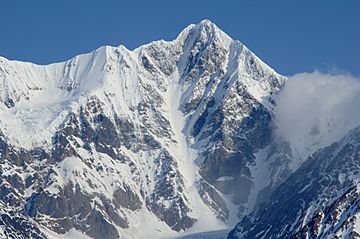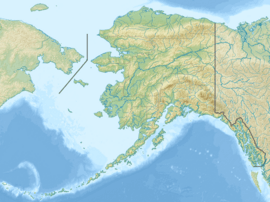McGinnis Peak (Alaska Range) facts for kids
Quick facts for kids McGinnis Peak |
|
|---|---|

South aspect from Black Rapids Glacier
|
|
| Highest point | |
| Elevation | 11,400 ft (3,500 m) |
| Prominence | 1,600 ft (490 m) |
| Isolation | 2.81 mi (4.52 km) |
| Parent peak | Mount Shand (12,660 ft) |
| Geography | |
| Location | Southeast Fairbanks Census Area Alaska, United States |
| Parent range | Alaska Range Hayes Range |
| Topo map | USGS Mount Hayes C-5 |
| Climbing | |
| First ascent | 1964, L. Muir, T. Knott |
| Easiest route | Northeast Ridge, technical climb |
McGinnis Peak is a tall, icy mountain in Alaska, United States. It stands about 11,400 feet (3,475 meters) high. This peak is part of the eastern Alaska Range and is the eighth-highest mountain in the Hayes Range. It's a remote place, far from cities.
You can find McGinnis Peak about 14 miles (23 km) southeast of Mount Hayes. It's also about 95 miles (153 km) southeast of Fairbanks. Two other mountains, Mount Moffit and Mount Shand, are nearby. The Richardson Highway is about 15 miles (24 km) to the east. When you drive south on this highway, McGinnis Peak, Mount Hayes, and Mount Moffit are big features in the landscape.
In 2002, a large earthquake called the 2002 Denali earthquake happened. Its center was about 35 miles (56 km) west of McGinnis Peak. Huge rockslides fell from the peak because of this earthquake. These slides moved a lot of rock and dirt.
Weather at McGinnis Peak
McGinnis Peak has a subarctic climate. This means it has very long, cold, and snowy winters. The summers are usually mild. This type of climate helps create the big glaciers around the peak. These include the Trident, Black Rapids, and McGinnis Glaciers.
Temperatures can drop very low, sometimes below −20 °C (−4 °F). With the wind chill, it can feel even colder, below −30 °C (−22 °F). The best time to visit or climb McGinnis Peak is from May to June. The weather is usually better then. Water from the mountain melts and flows into rivers that are part of the Tanana River system.
Climbing McGinnis Peak
Climbing McGinnis Peak is a challenging adventure. All the known climbing paths are technical. This means they require special skills and equipment. Some of these routes include the Northeast Ridge, the Southeast Ridge, and the Cut-throat Couloir.
The very first ascent (first time someone successfully climbed to the top) of McGinnis Peak happened on August 5, 1964. Larry Muir and Tom Knott were the climbers. They used the West Ridge route.
Years later, on June 21, 1976, John Garson and James Brady made the second ascent. They climbed the sharp Northeast Ridge. The Southeast Ridge was first climbed on May 5, 1980, by Walter Palkovitch and Dan Gray. The Cut-throat Couloir was first climbed in March 1985 by Roman Dial and Chuck Comstock. After reaching the top, climbers usually come down using the Northeast Ridge.
Images for kids





